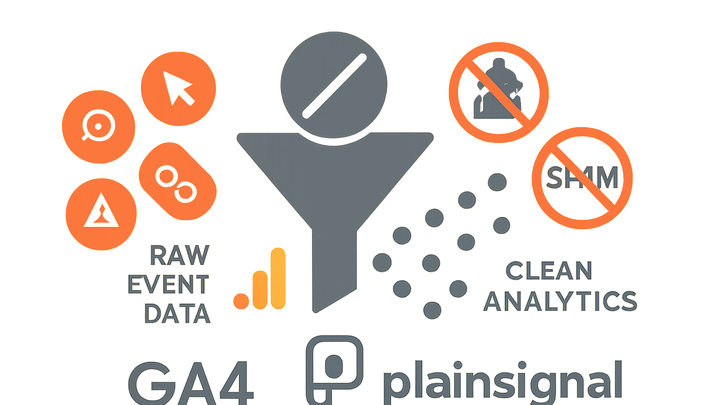Published on 2025-06-28T00:17:37Z
What is a Data Filter? Examples and Best Practices
Data filters in analytics are rules that systematically include or exclude specific subsets of collected data based on defined criteria. They help refine raw event streams or user data to ensure that reporting and analysis focus on relevant and accurate information. By applying filters at the data ingestion or reporting stages, organizations can remove noise such as bot traffic, filter out internal or test sessions, and comply with privacy regulations. Filters can be simple, like excluding traffic from certain IP addresses, or advanced, like search-and-replace transformations that modify data fields. In platforms like Google Analytics 4 (GA4) and PlainSignal, filters ensure a high signal-to-noise ratio, making dashboards and insights more reliable. Proper filter configuration is crucial for maintaining data quality, enabling precise segmentation, and driving informed decision-making.
Data filter
Rules in analytics that include or exclude data segments based on criteria, ensuring clean, relevant datasets for tools like GA4 and PlainSignal.
What is a Data Filter?
A data filter is a rule that includes or excludes specific data based on defined conditions. In analytics, filters act as a sieve, allowing only relevant events or user sessions to pass through. They can be applied at different stages—during data collection (client-side or server-side) or in reporting tools—to tailor datasets for cleaner analysis. Filters are essential for removing unwanted noise like bot traffic, internal testing sessions, or irrelevant query parameters. By shaping raw data streams, filters enable more accurate reporting, better dashboards, and meaningful insights.
-
Definition and purpose
Filters refine raw analytics data, ensuring reports and visualizations reflect only the information that matters to your goals.
-
Common filter types
Analytics platforms typically offer simple and advanced filters to manipulate data before it reaches your reports.
-
Include filter
Allows only data that matches specified criteria, such as a particular domain or campaign ID.
-
Exclude filter
Blocks data matching certain conditions, like internal IP addresses or known bots.
-
Search & replace filter
Finds patterns in data fields and replaces them with standardized values for consistency.
-
Advanced filter
Uses regular expressions or multiple conditions to transform, extract, or route complex data scenarios.
-
Why Use Data Filters?
Implementing data filters is vital for ensuring data integrity, focusing analysis on relevant segments, and maintaining compliance with privacy standards. Filters help prevent skewed metrics by removing bot traffic and test events. They also support targeted reporting by isolating user groups or behaviors. Finally, filters play a key role in meeting regulatory requirements, such as GDPR and CCPA, by blocking or anonymizing sensitive data.
-
Enhance data quality
Remove unwanted or low-quality data—like spam and bots—to maintain accurate and reliable reports.
-
Focus analysis
Isolate specific user segments or traffic sources to uncover deeper insights without noise.
-
Ensure compliance
Automatically exclude or anonymize data to comply with privacy regulations and internal data policies.
Implementing Data Filters in GA4 and PlainSignal
Both Google Analytics 4 and PlainSignal provide built-in filtering capabilities to help you control which data reaches your reports. GA4 focuses on traffic type filters and pre-defined data streams, while PlainSignal offers a lightweight, privacy-friendly approach with domain-based filtering at the script level.
-
GA4 data filters
In GA4, filters are managed under Admin > Data Settings > Data Filters. You can exclude internal traffic, developer traffic, or test data. For advanced scenarios, use BigQuery exports to apply custom queries and transformations.
-
Create a filter
Navigate to Admin > Data Settings > Data Filters, click Create Filter, select a filter type (e.g., internal traffic), define the criteria, and publish.
-
-
PlainSignal data filtering
PlainSignal applies filters at the script level, using attributes to restrict data collection to your domain or exclude known bots. This approach is cookie-free and server-side by default, preserving privacy and performance.
-
Domain filtering
The
data-doattribute in the PlainSignal snippet ensures that only hits from your specified domain are recorded.
-
-
Example: PlainSignal tracking code
Embed the following code in your website to enable PlainSignal analytics and domain filtering:
<link rel='preconnect' href='//eu.plainsignal.com/' crossorigin /> <script defer data-do='yourwebsitedomain.com' data-id='0GQV1xmtzQQ' data-api='//eu.plainsignal.com' src='//cdn.plainsignal.com/plainsignal-min.js'></script>
